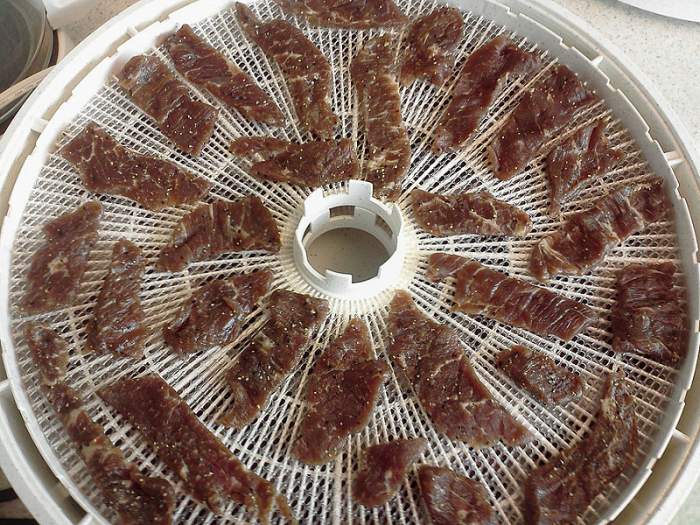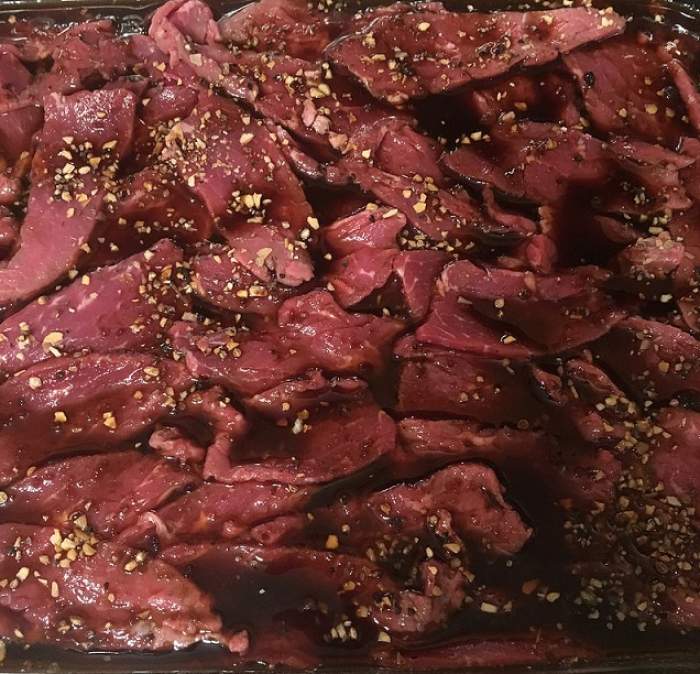How to Make Jerky
Jerky is a fabulous food for snacking or if you are prepping for an emergency. Jerky can also be used to flavor bean soups.

All of the marinade recipes below are sufficient for 1 pound of meat. If you want to use more meat, i.e., 2, 3 or 4 pounds, double, triple or quadruple the marinade ingredients. These recipes can be used for beef, bison, venison, salmon, chicken and turkey jerky. Choose your meat, then choose your marinade. You can also create your own marinade with the flavor combinations that you like best!
If you are using a dehydrator, make sure that you read the instructions before proceeding with the recipes. Generic instructions for a dehydrator are given below, but your dehydrator may have different guidelines.
Meat and Fish Choices
- skinless turkey breast, thinly sliced
- skinless chicken breast, thinly sliced
- beef top round, thinly sliced
- flank steak, thinly sliced
- venison, thinly sliced
- salmon, thinly sliced
Beef
- Either slice beef yourself about 1/8-inch thick or have your butcher slice it using the #2 setting on their slicer. Slice beef against the grain. This makes the jerky easier to chew and eat. Cutting with the grain will result in a chewier beef jerky.
- Cut all visible large pieces of fat from the meat.
Marinades
- Select your marinade from the list below. In a small bowl, combine all ingredients except meat. Stir to mix well.
- Place meat 3 or 4 layers deep in a glass, stoneware, plastic or stainless steel container, spooning mixture over each layer. Cover tightly.
- Marinate for 6 to 12 hours in the refrigerator, stirring occasionally and keeping mixture tightly covered.

Dehydrator Method
- Slice meat into long strips approximately 1/4 inch thick. Uniform slices will shorten the drying time, so use a meat slicer or have your butcher do it. If you slice the meat without an electric slicer, partially freeze it first to make cutting easier. Cut across the grain and remove excess fat.
- Once marinated, place meat on drying racks. Do not overlap the strips. For the dehydrator use a temperature setting of 140 to 160 degrees F. The temperature may be lowered to as low as 130 degrees F after 4 hours.
- Occasionally blot the meat with paper towels as it dries to remove beads of oil, if desired.
Oven Method
- Heat oven to 175 degrees F (80 degrees C). Line a baking sheet with aluminum foil and place a wire rack over the foil.
- Transfer meat to paper towels to dry. Discard marinade. Arrange slices in a single layer on the prepared wire rack on the baking sheet.
- Bake until dry and leathery, 3 to 4 hours. Cut with scissors into bite-size pieces.
- Dryness test: Test jerky for dryness by cooling a piece. When cool it should crack when bent but not break. There should be no moist spots.
- Storing jerky: Storage is affected by the curing preparation used and the humidity and temperature of the storage area. Jerky containing salt and cured without a commercial curing preparation may be stored at room temperature for 1 to 2 months. If the air humidity is low, the container should have a loose-fitting lid or one with wholes punched in it. Good air circulation keeps the flavor fresher.
- If the humidity of the air is more than 30%, store jerky in an airtight container. Jerky may be refrigerated or frozen in an airtight container to increase shelf life and maintain flavor.
Buffalo Chicken Jerky
- 1/4 cup + 2 tablespoons hot sauce (such as Frank's original, not buffalo wing sauce)
- 1/2 teaspoon salt
- 1/2 teaspoon black pepper
- 1/2 teaspoon garlic powder
- 1/2 teaspoon onion powder
- 1/4 teaspoon celery seed (optional)
Irresistable Beef Jerky
- 1/4 cup low-sodium soy sauce
- 1 tablespoon Worcestershire sauce
- 1 teaspoons coarsely-ground black pepper
- 1/2 teaspoon Liquid Smoke
- 1/2 teaspoon onion powder
- 1/2 teaspoon seasoned salt
- 1/4 teaspoon garlic powder
Peppered Beef Jerky
- 2 cloves garlic, minced
- 1/2 cup soy sauce
- 1/4 cup Worcestershire sauce
- 1/4 cup brown sugar
- 1 teaspoon onion powder
- 1 teaspoons red pepper flakes
- 1 tablespoons black pepper
- 1/2 cup beer or beef stock
Flavorful Jerky
- 2 tablespoons Worcestershire sauce
- 1 tablespoon dried minced onion
- 4 cloves fresh garlic, crushed
- 1 tablespoon dried minced onion
- 1/4 cup balsamic vinegar
- 1 tablespoon salt or seasoned meat tenderizer (this will have salt)
- 1/4 cup water
- 1 tablespoon coarsely ground black pepper
Simple Turkey Jerky
- 6 tablespoons teriyaki sauce
- 1 tablespoon dark brown sugar
- 1 teaspoon hickory salt
Western Barbecue Jerky
- 1 teaspoon salt
- 3 tablespoons brown sugar
- 1/4 teaspoon pepper
- 1/3 cup red wine vinegar
- 1/8 teaspoon cayenne pepper
- 1/3 cup ketchup
- 1 teaspoon onion powder
- 1/2 teaspoon garlic powder
- 1 teaspoon dry mustard
Southwestern Jerky
- Juice of 1/2 lime
- 2 cloves fresh garlic, crushed or 1 tablespoon minced garlic
- 1 serrano pepper, chopped
- 1 tablespoon tomato paste
- 1/8 cup cilantro, chopped
- 1 tablespoon Cholula, Tabasco or other hot sauce
- 1 tablespoon worcestershire sauce
- 1/2 tablespoon salt or seasoned meat tenderizer (this will have salt)
Hot and Tangy Jerky
- 1 teaspoon salt
- 2 garlic cloves, crushed
- 1/4 teaspoon cracked pepper
- 2 tablespoons A-1 sauce
- 1/4 teaspoon cayenne pepper
- 3 tablespoons Worcestershire sauce
- 1 teaspoon onion powder
- 1/2 teaspoon paprika
Hawaiian Jerky
- 1 teaspoon salt
- 1 garlic clove, crushed
- 1 teaspoon ground ginger
- 1/4 cup pineapple juice
- 1 tablespoon brown sugar
- 1/4 cup soy sauce
- 1/4 teaspoon pepper
- 1/8 teaspoon cayenne pepper
Fiesta Jerky (hot and spicy)
- 1 teaspoon salt
- 1 teaspoon onion powder
- 1/4 teaspoon pepper
- 1/4 teaspoon ground cumin
- 1 tablespoon chili powder
- 1 teaspoon garlic powder
Middle Eastern Jerky
- 1 teaspoon salt
- 1/4 teaspoon turmeric
- 1/8 teaspoon pepper
- 1/8 teaspoon ground cumin
- 1 1/2 teaspoon coriander
- 1/4 teaspoon chili powder
- 1/4 teaspoon ground ginger
Korean Jerky
- 1/2 teaspoon salt
- 1 tablespoon dry sherry, if desired
- 1/4 teaspoon pepper
- 2 teaspoons sugar
- 1/4 cup soy sauce
- 2 tablespoons sesame seeds*
* Follow standard directions (above), but leave out the sesame seeds. Those get sprinkled on as the wet meat is put into the dehydrator.
Teriyaki Jerky 1
- 1/2 teaspoon kosher or sea salt
- 1 garlic clove, crushed
- 1/8 teaspoon pepper
- 1/4 cup soy sauce
- 1/2 teaspoon ground ginger
- 2 tablespoons brown sugar
Teriyaki Jerky 2
- 1/8 cup sesame seeds
- 2 cloves fresh garlic, crushed or 1 tablespoon minced garlic
- 1/2 tablespoon fresh ginger, chopped
- 1 serrano pepper, chopped
- 1/8 cup soy sauce
- 1/8 cup frozen orange juice concentrate
- 1/8 cup sugar
- 1 tablespoon Worcestershire sauce
- 1/2 tablespoon salt or seasoned meat tenderizer (this will have salt)
- 1/2 tablespoon coarsely ground black pepper
Mild Mexican Jerky
- 1 teaspoon kosher or sea salt
- 1/2 teaspoon oregano, crushed
- 1/4 teaspoon pepper
- 1 teaspoon paprika
- 1 teaspoon chili powder
- 1/2 teaspoon garlic powder
Frontier Jerky
- 1 teaspoon kosher or sea salt
- 2 tablespoons Liquid Smoke
- 1/4 teaspoon pepper
- 1 teaspoon garlic powder
- 2 tablespoons Worcestershire sauce
Curried Jerky
- 1 teaspoon kosher or sea salt
- 1 1/2 teaspoons curry powder
- 1/4 teaspoon pepper
- 1/2 teaspoon garlic powder
- 1/8 teaspoon cinnamon
- 1 teaspoon ground ginger
- 1/16 teaspoon ground cloves
- 1/8 teaspoon ground cumin
Sweet and Sour Jerky
- 1 teaspoon kosher or sea salt
- 1 tablespoon soy sauce
- 1/4 teaspoon pepper
- 1/4 cup red wine vinegar
- 1/2 teaspoon onion powder
- 1/4 cup pineapple juice
- 1 garlic clove, crushed
- 3 tablespoons brown sugar
Terrific Jerky
- 3/4 teaspoon kosher or sea salt
- 2 tablespoons soy sauce
- 1/4 teaspoon cracked pepper
- 1 tablespoon Worcestershire sauce
- 1 tablespoon brown sugar
- 1 garlic glove, crushed
Air Fryer ~ American Regional ~ Appetizers ~ Baby Food ~ Back of the Box ~ Beans ~ Beverages ~ Bowls/Buddha Bowls ~ Bread ~ Breakfast/Brunch ~ Camping/Hiking ~ Candy ~ Canning ~ Casseroles ~ Celebrity ~ Condiments ~ Cookies ~ Cooking for a Crowd ~ Cooking for Two ~ Cowboy/Ranch ~ Crock Pot ~ Dessert ~ Diet ~ Energy Bars ~ Family Favorites ~ Fish/Seafood ~ Gifts in a Jar ~ Grill ~ Holidays ~ Home Remedies ~ Instant Pot ~ International ~ Jiffy Mixes ~ LuAnn's Family Favorites ~ Meat ~ Meatless ~ Mixes ~ Name Brand ~ Nutella ~ Packet Cooking ~ Pampered Chef ~ Pasta/Rice/Beans ~ Pet Food ~ Picnic ~ Pizza ~ Potluck ~ Pressure Cooker ~ Restaurant ~ Salads/Salad Dressings ~ Sandwiches ~ Sauces ~ School Cafeteria ~ Seasoning/Flavored Oil/Vinegar ~ Sheet Pan ~ Side Dishes/Veggies ~ Snacks ~ Soup/Stew/Chili ~ Spreads ~ State Fair ~ Syrup ~ Tofu ~ TVP ~ Two-Ingredients ~ Vegetarian ~ Wild Game
Articles ~ Cooks Corner ~ Glossary (Dictionary) ~ Household Hints ~ Kitchen Hints

